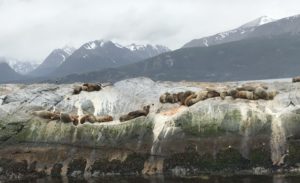At 4:30 this morning we sailed into Glacier Avenue in the Alberto De Agostini National Park. The sun was coming up and the mountains were spectacular.



From our balcony we could photograph the glaciers we passed, the Espana, Romanch, Alemania, Francis, Italia, and Hollanda. They are tidewater glaciers that flow from the Darwin Mountains to the ocean.


Ushuaia, Argentina, calls itself the southernmost town in the world. It is on the Beagle Channel at the southern end of Tierra Del Fuego, only 750 miles from Antarctica. The sun comes up around 4am and it doesn’t get dark until after 10pm.
We did an excursion that took us to the Tierra del Fuego National Park where we visited the end of Route 3, the Pan-American Highway, a spot that overlooks the Beagle Channel with Chile across the water and Argentina on this side.  Unfortunately, the spot was overwhelmed with buses from the ship and lost some of its charm. The same went for our next stop at Lake Acigami. Seeing the Park was interesting but I would not recommend doing it on a ship excursion bus, way too many people at each stop.
Unfortunately, the spot was overwhelmed with buses from the ship and lost some of its charm. The same went for our next stop at Lake Acigami. Seeing the Park was interesting but I would not recommend doing it on a ship excursion bus, way too many people at each stop.
The park and the entire island has been plagued by terrible decisions about importing animal to solve problems, which of course created more problems. They imported rabbits to solve some problem; then imported foxes to kill the rabbits, but the foxes preferred the native birds, then they imported beavers, which proceeded to destroy forests.That seems to be the sad story of so many islands we have visited, Hawaii and New Zealand to name just two.
The afternoon portion of the trip made up for the unpleasant morning of bus hell. We took a catamaran out of Lapataia Bay into the Beagle Channel, where we saw the end of the world lighthouse with nesting Imperial cormorants and the slightly smaller rock or Magellan cormorants.
Next, we sailed by several small rock outcrops with sea lions. The first held mostly females.


Next we sailed by an island of nesting South American terns making quite a racket.
Then we sailed by an island with yet more cormorants, Several white kelp geese, and flightless Stanley ducks.

The last island we passed had several male sea lions.
Earlier, we saw a chimango caracara. 180 years ago, Charles Darwin sailed these waters on his historic H.M.S. Beagle expedition. Today, one can still see the variety of bird and animal life that fascinated him.This was one of the most spectacular days of the trip so far.







